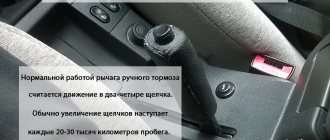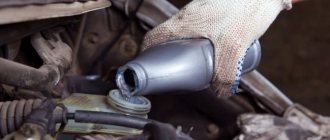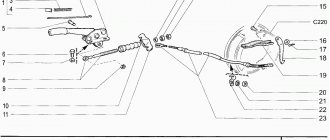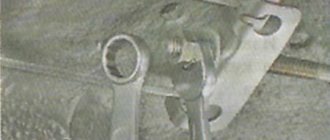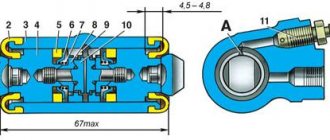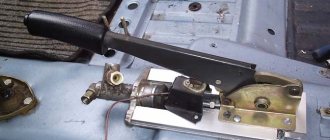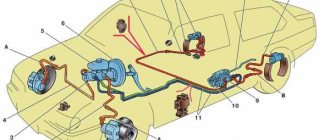Everyone knows that the parking brake, which is popularly called the “handbrake,” should make it possible to park a car on a 25 percent slope. In this case, the lever should be installed in 3-5 positions. Most owners of a Lada Priora car do not know how to tighten the handbrake on a Priora, which will be discussed further.
I would like to immediately note that in order to perform this procedure as comfortably as possible, you will need to use an inspection pit or a lift.
Why the handbrake on a car might get stuck and how to fix it
Handbrake jamming is not the most common malfunction. But many motorists have encountered it over the years of operation.
There are several main reasons why the handbrake gets stuck. This may be due to weather conditions, or problems with the mechanical component of the unit.
And if the problem of icing is quite easy to solve using available means, then dealing with malfunctions will be much more difficult.
What causes the handbrake to jam?
You should start with the reasons why the handbrake may not raise or lower. What most often happens is that the parking brake does not want to be released after the car has been parked in the cold for quite a long time.
Let's highlight the main reasons why the unit may jam, and the wheel will not want to be blocked or freed from the strong embrace of the brake pads.
- Mechanical problems. The handbrake is activated by pressing the brake pad against the disc or drum. This activates the brake and the car cannot move. If the block gets stuck in this position, the car will not be able to move. As for why this happens, the main reason lies in the block itself, or in the cable. The latter needs to be adjusted or replaced.
- Freezing. The most likely reason why the handbrake does not release completely, or does not want to engage when you try to pull the lever. This freezing is caused by the accumulation of snow or icy water after driving on winter roads. A layer of ice firmly envelops the assembly, which is why the resulting crust does not allow the hand parking brake to be released.
In case of freezing or jamming due to mechanical reasons, do not under any circumstances try to solve the problem with physical force. Do not pull the handbrake sharply towards yourself, do not try to pull it with both hands.
If the brake does not respond with normal pressure, there is a problem. It needs to be found and then eliminated.
What to do if there is no result
Sometimes motorists are faced with situations in which tightening the cable does not improve the quality of the handbrake. In this case, it is necessary to deal directly with the brakes. The main culprit is the brake pads. They can:
- wear out;
- “get stiff” and not respond to handbrake commands.
Installing new brake pads will help achieve normal results. Experts recommend dismantling the brake drums and checking the movement of the brake pads. If they don't move, it means they're stiff. If there is still movement, the problem must be looked for in other nodes. The primary culprit may be a stretched handbrake cable. If all else fails, it is best to turn to professionals.
How to solve a problem
Naturally, motorists are interested in what to do if the handbrake is jammed, and how this could turn out.
There are 2 main situations when there are problems with the parking brake:
- the car does not want to be released from the handbrake;
- The car cannot be put on the handbrake.
It would be fair to call the first situation jamming. We’ll tell you more about it.
Since the handbrake does not release and continues to block the wheels, it is important to first exclude the option of freezing. If it is a warm season and there were no frosts at night or while the machine was idle, the jamming occurred precisely for mechanical reasons. Some kind of breakdown occurred.
There are several potential culprits and solutions to the problem here.
- Handbrake cable jammed or broken. It needs to be inspected and adjusted. If the defect is serious, it will have to be replaced.
- Jamming due to rust formation. Relevant for machines that have been idle for a long time and have not been used. At the same time, the car was stored in a humid environment. Rust has stuck to the pads, caliper or brake disc (drum). This will require dismantling, cleaning or replacing elements.
- The pad linings became soggy, which caused them to stick to the drums. You will probably have to solve the problem by replacing the elements.
Some motorists advise trying to move forward and backward, tap the problem unit with a hammer, insert a pry bar into the gap between the jammed block, and manually try to loosen it.
In reality, such actions can lead to serious consequences. It is better to carefully examine the condition of the handbrake, determine the cause of the jamming, and carefully eliminate it by sequential dismantling, or by contacting a car service.
If the problem is related to the fact that the block is frozen, which can be determined by the presence of an ice crust and indirect signs such as driving through puddles and freezing temperatures, it is much easier to solve.
How to solve the problem of the handbrake jamming in the cold
When your parking brake suddenly jams after a long period of parking in the cold, there is a very high probability that the brake pads will freeze.
This problem can be solved quite quickly in several accessible ways.
- Use of defrosters. These are special liquids, mainly alcohol-based. You can find them in specialized stores in the auto chemicals department. The principle of using funds is extremely simple. You need to spray it on the frozen assembly, wait a while, and then try to unlock the handbrake. If you live in a region with cold and wet winters, having such a can with you will never be a bad idea.
- Using a hair dryer. A very reliable, effective and fast way to remove ice from a handbrake. The only problem is that not every motorist has such a hairdryer at his disposal. Plus, to connect you will need a household outlet or a car inverter. An alternative is a regular household hair dryer, but its power is not enough to quickly resolve the issue. You will have to hold the device aimed at the brakes longer. Here the issue of connecting to the power grid remains relevant too.
- Defrosting with its own exhaust pipe. The meaning is quite simple. You will need a rubber hose that is large enough to fit onto the exhaust pipe. It should also be long enough to extend the other end of the hose to the brakes. Next, start the car and begin to warm up. Hot air comes out of the exhaust pipe, it passes through the hose, and warms up the handbrake.
- Available liquids. Another method involves using suitable liquids. These include antifreeze, alcohol or gasoline. They are applied to the pads and waited for some time. As soon as the ice thaws, the handbrake can be unlocked.
And there are 2 methods that should be abandoned. They should only be used as a last resort. And even in this situation it is better to do without such measures.
Some bad ideas for defrosting a jammed handbrake include the following methods.
- Hot water. There is severe frost outside, due to which the pads froze. The brake system elements themselves are also cold. Now imagine that a large amount of hot water or boiling water suddenly hits the parts. This leads to a sharp temperature drop. As a result, the metal may crack. This will lead to breakdown of expensive components and the need to replace them. Therefore, the idea of boiling water is categorically not welcomed.
- Physical impact. Quite often, motorists try to solve the problem of jamming due to freezing or mechanical failures using physical force. Trying to break the handbrake if it is jammed is strongly not recommended. If there is no other way out, you should get behind the wheel, start the engine, and try to rock the car forward and backward with short presses on the gas.
Disrupting the handbrake by physical force can potentially cause serious damage to the suspension and braking system components.
Therefore, these methods are necessarily included in the list of prohibited methods. Only in certain circumstances, when there is no other solution and cannot be, is their use allowed.
Why doesn't the handbrake hold (the parking brake doesn't work). Main reasons
To be honest, the handbrake or handbrake is not particularly needed in the city, especially if you have an automatic car and you have a parking mode . Yes, and in manual mode, drivers mostly put the car in gear. Why? Yes, it’s simple - our climate is harsh, and therefore if you put on the parking brake in winter, you can get into an unpleasant situation - they will simply freeze to the rear drum brakes. However, as the traffic rules teach us, you need to set it to avoid emergency situations, for example, you left the car in neutral gear, forgot to put the handbrake on - GONE, and it rolled. It's not far from an accident! Therefore, when undergoing maintenance, this braking element must be checked; if it does not work (does not hold), then you will not pass the technical inspection. But why does this happen, what are the reasons? Let's find out...
THE CONTENT OF THE ARTICLE
The handbrake or handbrake is just a scourge on our VAZs. Very often it turns out that you lift the handle of this brake, but nothing happens - that is, the car rolls.
When undergoing a technical inspection, there is a golden rule:
If the car stops after three clicks, it means the handbrake is working and you can issue the coveted ticket. But if it doesn’t hold well with 4 or more clicks, then the performance is at a low level, or it doesn’t exist at all!
Faulty cars are sent to be repaired or the handbrake tightened, without it there is no way.
Reasons for adjusting the parking mechanism
The condition of the brakes should be checked once every 30,000 kilometers or monthly. If you suspect that something is wrong with the device, you can check the part more often, especially since there is nothing complicated in such a check, and it goes very quickly.
- You can drive up a steep hill and tighten the handbrake handle well. If the car doesn't start to roll after you release the main pedal, then everything is fine. If the car starts to move, try to tighten the handle more, is it the same? You can safely drive the car into the inspection pit and change consumable parts.
- There is another way to check functionality. Engage the first gear, pull up the handbrake handle and slowly, smoothly, start to move away; if the handbrake is working, nothing will work out for you, and the engine will simply stall. If the car moves, although it is slow, it means that the handbrake needs to be tightened, traffic safety is already at risk. To do this, again drive the car into the pit and inspect the system.
Why the handbrake may not work:
- The cable is very weak.
- The pads are worn out.
- Large gap between the linings and the disc (drum).
How do they work?
The operation scheme is banal and simple - there is a handle that is connected to a cable, which in turn is in a special braid (that is, the cable runs in it). Then this cable is hooked onto a special adjusting bolt (it can be tightened and loosened), which is engaged with a bar, along the edges of which there are two more cables that go to the two rear wheels. And these cables (extending to the wheels) are engaged with a special bracket, it is this that opens the pads and blocks the drums.
That is, in simple words, when you move the handle up (raise the handbrake), the cable stretches and pulls two separate cables to the wheels. Inside the drums, the brackets are unclenched, which spread the rear pads, due to which the wheels are blocked.
Let's watch a short video and it will become clearer.
Hydraulics or mechanics
It is worth noting that at the moment not all rear brakes are cable or mechanical; now there are quite a large number of handbrake brakes that operate hydraulically, this is especially true for rear disc brakes rather than drum brakes . Hydraulics duplicate the operation of the main braking system.
That is, when you lift the handle, a special piston creates pressure on the rear discs and they are blocked. If the handbrake does not work in such a system, then the reasons are significantly different from its mechanical counterpart.
Reasons why the handbrake does not work
Often the reasons are trivial, and the work itself only takes 10 minutes (more on that a little later), but now I’ll list the main points:
- Wear of rear brake pads . Usually accompanied by a grinding noise when braking. Here, tighten, don’t tighten the cable, nothing will work. First you need to replace the pads, preferably on both wheels at once, because they wear out evenly.
- Incorrectly adjusted parking brake . This also happens, the adjusting bolt is simply loose - you need to tighten it.
- Cable wedge in sheath . This often happens over time, and often appears on 5 year old or older cars. The fact is that moisture gets between the sheath and the cable itself, after which the rust and the cable get stuck in the sheath. There are two ways here, either lubricate it and develop it so that it runs normally. Or you should replace the cables with new ones.
- Broken cable . Sometimes the cable breaks, both from the handle itself and under the car, it needs to be replaced.
- Ice or salt, reagents on the surface of the pads . It happens rarely, but it does happen, especially after driving through deep puddles. It is worth cleaning the pads with gentle pressure when driving short distances. All plaque should be cleared.
- Oil or brake fluid getting on the pads . For example, the working cylinder is leaking, or the rear axle seal may be leaking. Here you first need to remove the cause of the leak, then clean the pads. Of course, they will clean themselves after several braking cycles. If the “oiling” is strong, then you need to replace the pads with new ones, because the surface of the linings can be completely saturated with oil.
I know from experience that these are mainly the first four reasons. For example, on our VAZs, very often the cable in the sheath rusts from time to time, or it breaks, and you need to tighten it in time.
How much does it cost to tighten the handbrake and can you do it yourself?
In fact, the question is rhetorical, as you understand, in different regions the cost can vary from 200 to 1000 rubles. For example, in the capital the price is often 500 - 1000, but in the regions it is possible to tighten it by 250 rubles.
And to be honest, the work itself literally takes a few minutes, the main thing is to find a pit or elevator, a key for 10, and so on. You need to tighten the central bolt, the one in the middle is the parking brake, tighten the nut and then tighten the cables.
Of course, if they are rusty or torn, then everything is much more complicated; it is better to trust a specialist, because replacing the cables from the rear drums is not at all easy.
That's all, read our AUTOBLOG, I think this clarifies the situation.
(7 votes, average: 4.57 out of 5)
Similar news
Rust converter composition. Can you do it yourself?
How to unscrew a brake hose. If it is sour and the edges are torn.
Anti-squeak brake pad linings. What is i.
Add a comment Cancel reply
Hello everyone, I decided to write my review of the Toyota Avensis 2010. I just want...
TOP articles per month
I have many different articles and videos about different gearboxes, for example here...
I already have an article on the website about choosing memory cards (you can see it here), a lot...
In the article - is it possible to open windows when the air conditioner is running (can be read here) I was asked...
The handbrake won't go up! Help.
The handbrake won't go up! Help.
Post by DmitriyOpel » 03 Aug 2016 19:24
Re: Handbrake won't lift! Help.
Post by hsl87 » 03 Aug 2016 19:30
Re: Handbrake won't lift! Help.
Post by DmitriyOpel » 03 Aug 2016 20:03
Re: Handbrake won't lift! Help.
Post by hsl87 » 03 Aug 2016 20:55
Re: Handbrake won't lift! Help.
Post by Nec » 04 Aug 2016 09:54
Re: Handbrake won't lift! Help.
Post by shmaks » 04 Aug 2016 10:20
Re: Handbrake won't lift! Help.
Post by Dick » 04 Aug 2016 14:59
Re: Handbrake won't lift! Help.
Post by DmitriyOpel » 04 Aug 2016 18:30
Re: Handbrake won't lift! Help.
Post by shmaks » 04 Aug 2016 21:13
Re: Handbrake won't lift! Help.
Post by DmitriyOpel » 12 Aug 2016 22:16
Re: Handbrake won't lift! Help.
Post by Nec » Aug 12, 2016 11:29 pm
Re: Handbrake won't lift! Help.
Post by DmitriyOpel » 13 Aug 2016 12:05
Re: Handbrake won't lift! Help.
Post by Nec » 13 Aug 2016 14:05
Re: Handbrake won't lift! Help.
Post by katalll » Aug 13, 2016 4:32 pm
Re: Handbrake won't lift! Help.
Post by mrakus » 13 Aug 2016 17:03
The problem is not what's on top. It's only dirty and rusty on the outside, but the main thing is working BELOW. That’s the crap that’s pushing the pads at the bottom, and that’s what’s pushing them apart (those who have a brain in their head will understand this without any problems) you need to completely dismantle the pads and clean the crap on top. and give it a good beating and clean out the crap from underneath with a grinder. for it stands like a cast-iron bridge. After the mobility of the pad drive from below has been restored and greased with soldidol, then everything can be put back together.
But the easiest way to check is to pull the cable near the wheel with your hand. With a working system, everything is clearly visible. If it’s faulty, figure out what’s faulty is also clearly visible. Well, if you have the skill to think...
Re: Handbrake won't lift! Help.
Post by DmitriyOpel » 13 Aug 2016 18:32
Re: Handbrake won't lift! Help.
Post by FDutch » Aug 13, 2016 7:28 pm
Re: Handbrake won't lift! Help.
Post by DmitriyOpel » 13 Aug 2016 19:47
Re: Handbrake won't lift! Help.
Post by FDutch » 13 Aug 2016 20:38
Re: Handbrake won't lift! Help.
Post by DmitriyOpel » 13 Aug 2016 21:43
Re: Handbrake won't lift! Help.
Post by katalll » 13 Aug 2016 21:49
Re: Handbrake won't lift! Help.
Post by FDutch » Aug 13, 2016 10:31 pm
Re: Handbrake won't lift! Help.
Post by Nec » Aug 13, 2016 11:56 pm
Can't you pull the main cable out of the crap that is number 9 in the picture?
If yes, then just pry it open with a screwdriver. And since your khan’s cable is no longer there, there’s no need to stand on ceremony with it, you need to cut it off in any way and install a new one. The caliper on my OVTS was sour, so I sawed it with a grinder, and then knocked it out in a vice. The outer braid was cracked and rust had accumulated there, causing it to jam.
Re: Handbrake won't lift! Help.
Post by mrakus » 14 Aug 2016 06:50
Re: Handbrake won't lift! Help.
Post by DmitriyOpel » 14 Aug 2016 12:19
Progress
So, initially you will need to prepare the necessary tool. Fortunately, tightening the cable does not require a lot of tools; you can get by with two 13-size open-end wrenches. Before starting work, you need to drive the car onto an overpass or pit, this will be much more convenient for you. It is important to know that according to regulatory documents, the handbrake must hold the car on a slope of up to 25%.
So, if you have installed the car, you will need to engage first gear and lower the lever to the down position. The next step-by-step instructions are as follows:
- Remove the heat shield. It is secured with 4 fasteners, which will need to be removed, then the cover should be removed and set aside.
- Under the cover there is a special rubber stand, which is attached to the additional muffler.
- Once you remove the heat shield, you will be exposed to nuts that allow you to adjust the handbrake. You will need to look for the one that allows you to set the position of the tip.
- The end nut is additionally secured with a lock nut, which must be loosened. There is no point in removing it, just twist it a couple of turns. Make sure there is nothing obstructing the nut. Experts recommend loosening both nuts at once, because in this case the cable will immediately tighten.
- The locknut must be returned to its original position and tightened tightly, because the safety of your car depends on it.
When everything is ready, you can perform a control test. Return to the driver's seat, engage neutral and set the brake to park.
When fixing the lever, you need to count the number of clicks. With an average pressing force, their number will not exceed 5 times.
Second test. By lowering the handbrake to its extreme position, you need to check whether the rear wheels are spinning well. If everything is good, then they will spin easily, without any significant effort. If something interferes with them, then you will have to loosen the nut again and tighten it. Next, the devices are installed in the reverse order. If any points remain unclear to you, you can watch the video on our website.
Messages 5
1 Topic by DreamQa 2014-08-10 12:33:59 (2014-08-10 12:34:51 edited by DreamQa)
- DreamQa
- User
- Offline
- Registered: 2014-07-25
- Messages: 1
- Reputation: [ 0 | 0 ]
Subject: Handbrake lever won't lift
actually subject. I am a motorist so-called “teapot”
and therefore I don’t really rummage) I searched the Internet especially about my problem and didn’t find anything in the end, the handbrake lever only rises by 1 or 2 (barely) clicks and doesn’t hold at all)
2 Reply from hamlet 2014-08-10 13:41:56
- hamlet
- User
- Offline
- Registered: 2008-11-20
- Messages: 1,503
- Reputation: [ 14 | 0 ]
Re: Handbrake lever won't lift
Maybe the cables need to be changed, they're probably soured.
3 Reply from vilatik 2014-08-10 15:41:24
- vilatik
- Vasochist
- Offline
- Registered: 2008-11-10
- Messages: 2,461
- Reputation: [ 8 | 0 ]
Re: Handbrake lever won't lift
I give a thumbs up to the cables. I recently changed it myself and finally the handbrake is working)
4 Reply from nik77d 2014-08-10 16:54:39
- nik77d
- User
- Offline
- Registered: 2014-07-20
- Messages: 37
- Reputation: [ 6 | 0 ]
Re: Handbrake lever won't lift
and if, together with the cables, you change the pads and drums AND ADJUST the handbrake according to your mind, IT WILL BE LIKE NEW - EVERYTHING WILL BE AS IN GOST “2-3 clicks”. But you have to puff a little, but there’s a reason for it.
5 Reply from hamlet 2014-08-11 07:21:14
- hamlet
- User
- Offline
- Registered: 2008-11-20
- Messages: 1,503
- Reputation: [ 14 | 0 ]
The handbrake does not work - causes and solution to the problem
The parking brake, or as it is popularly called the “handbrake,” although it is intended to immobilize the car while parking, not all drivers and do not always use it. If the car has an automatic transmission, then, by and large, a handbrake is not needed at all, but owners of cars with manual transmission, as a rule, prefer to leave the car in first gear when parking. This is due to one of the most important reasons - harsh winter conditions and poor road quality may not allow the handbrake to operate when necessary. This may be caused by icing on the pads or clogged pads. But first things first.
Brief conclusions
Adjusting the handbrake is a simple process. It should be carried out regularly so that the car does not fail while driving. Many people turn to service centers to carry out such work. It is better to perform the adjustment at home to be sure of the result.
Priora cabin filter: Features
Selection and replacement of antifreeze in Priora
How does the handbrake system work?
Applying the parking brake activates the rear brakes and ensures that the vehicle does not roll, even on a relatively steep incline. However, if the handbrake does not hold the vehicle, there is a problem that must be corrected to ensure the safety of the driver and others.
Parking brake systems vary greatly from one automaker to another and even between different makes and models of cars. In general, they are divided according to the type of brakes and the method of their use.
It is immediately necessary to understand that in the vast majority of cases in passenger cars, parking brakes use the rear wheels and are divided into two types:
- drum - consisting of two semicircular blocks that are located inside a cylindrical drum. If, on one side, they are rigidly fixed, then on the other there is a special piston mechanism that forces the pads to move when using the handbrake;
- disc brakes - consisting of a special brake disc mounted on the car axle and two pads. When you use the handbrake, the pads compress and prevent the car from moving.
The car's braking system can also be mechanical or hydraulic. If in the first option, braking is carried out using a system of cables and the force of a person who puts pressure on the handbrake, then a special piston is used in hydraulics.
Important! Depending on the type of braking system, the reasons why the handbrake does not hold may vary significantly.
What is the importance of system health?
The serviceability of the parking lock is very important, like any other elements included in the list of the car’s braking system. Tasks that a well-functioning handbrake performs:
- Ensures that the machine stops on any uneven terrain (rises, slopes, etc.).
- Helps in situations where the main brake has failed or during emergency braking.
- Creates a controlled skid (requires certain skills).
- Can temporarily replace the main system (when it fails).
But remember - the use of such a mechanism instead of the main system is strictly prohibited, if only because it is not intended for this. As a last resort, when such use is still necessary, do not apply the handbrake too sharply, this can cause the car to skid, provoking a dangerous situation in which both you and other road users may suffer.
The handbrake consists of three main parts:
- Handbrake drive.
- Actuating mechanism.
- Control node.
The drive is a metal cable. It is this cable that activates the car’s brake pads or its stopping system (depending on the design features of the car). The part that transmits force to two cables is designed to evenly distribute the force between the wheels.
How does the handbrake work?
When the driver activates the handbrake, either by pulling the handle between the front seats (3) or by pressing the parking brake pedal under the dashboard, a cable (12) running to the rear of the car is pulled, applying tension to the brake pads. When the driver lowers the handle, the return spring (11) helps return the brake system to its normal configuration.
The system itself is quite simple and banal - the parking brake handle is connected to a cable in a special plastic sheath, in which it can move freely. This cable goes to the adjusting bolt, which can be loosened or tightened. Then it splits into two cables that go to the brakes on the rear wheels.
In simple words, by activating the handbrake, the cable tightens and brings the pads together, which then secure the car.
Basic faults
According to the law, a malfunction of the handbrake is accepted in two cases:
- If, at a 16% slope, the handbrake does not hold the equipped car (without cargo and passengers, but with a full tank of gasoline, the driver’s weight is taken to be 75 kg).
- If, on a 23% incline, the handbrake does not hold the vehicle at full load (the maximum permissible vehicle weight has been reached).
In reality, more often than not, a malfunction of this brake mechanism of the Lada Priora is noticed not by measuring the steepness of the slope, but by clicks. When another click of the handbrake is added to the usual “set of sounds” when leaving the car, every car enthusiast understands that it’s time to tighten the cable.
But the problems don't end there. For the parking brake system they can be as follows:
- The cable has stretched too far. Over time, it undergoes deformation. It can be tightened, but to a certain extent.
- The cable broke. When the “limit” is reached, the mechanical device will have to be replaced.
- The handbrake indicator on the dashboard does not light up or go off. This is due to the sensors.
- The lever button is stuck.
Causes of malfunction and their elimination
As a rule, the reasons why the handbrake does not work are quite simple and do not require long or expensive repairs:
- torn cable . One of the common causes is a broken cable on the handbrake or under the car. The problem is solved by simply replacing the cable;
- jammed cable . Due to damage to the sheath in which the cable moves, it may become jammed, preventing you from using the handbrake. And the cable itself consists of many steel strands, which, if damaged, can also prevent proper operation. The solution is to replace the cable;
- dirty brakes . If dust, dirt, ice or reagents that are sprinkled on roads in winter get on the pads, this can cause the brakes to not work properly. The solution is to press the brake pedal several times smoothly while the car is moving. Thanks to friction, the pads will be cleaned;
- incorrect adjustment . It may happen that the cable system is not adjusted properly, the bolt is not tightened correctly, or the length of the cables is incorrectly selected. The solution is to adjust the system and correct tension of the cables;
- pad wear . The pads are subject to abrasion during operation. Every time you apply the brakes, the pads gradually become unusable. The solution is to replace the pads;
- oil in the pads . Oil or brake fluid leaks can cause the car to not hold up with the handbrake. The most important thing in this case is to identify the cause of the leak - it could be the rear axle seal or the brake cylinder. The solution is to eliminate the leak and clean the pads. If the pads are very oily, replace them.
Adjusting and replacing the parking brake cable of a VAZ 2110
When the car is on a level surface, and a mechanic with a 13 and 14 wrench, pliers and WD40 fluid is under the car, he can begin to adjust or replace the cable. Adjustment is made by releasing the locknut and tightening the adjusting nut to the desired cable tension. In order to remove the nut, you will most likely have to use either WD40 or brake fluid to soak up the dirt.
To replace the handbrake cable, it is necessary to completely dismantle the rear brake drums and the old cable. The operation itself is not complicated, but it will take a couple of hours precisely because of the amount of dismantling work. It is advisable to change both cables in pairs, so that after replacement you do not have to disassemble a second time, but this time of a different wheel.
Diagnostics
What to do if you couldn’t identify the reasons yourself? In this case, you should contact a car service center, where a mechanic will carefully inspect the entire system. To do this, you may need to remove the rear wheels and check the drums. In any case, handbrake breakdowns do not require expensive repairs, since important components and assemblies in the braking system are not involved.
It is important to know how many clicks the handbrake should have. The golden rule of auto mechanics is THREE clicks, then the parking braking system is considered working.
What to do if there is no result
Sometimes motorists are faced with situations in which tightening the cable does not improve the quality of the handbrake. In this case, it is necessary to deal directly with the brakes. The main culprit is the brake pads. They can:
- wear out;
- “get stiff” and not respond to handbrake commands.
Installing new brake pads will help achieve normal results. Experts recommend dismantling the brake drums and checking the movement of the brake pads. If they don't move, it means they're stiff. If there is still movement, the problem must be looked for in other nodes. The primary culprit may be a stretched handbrake cable. If all else fails, it is best to turn to professionals.

